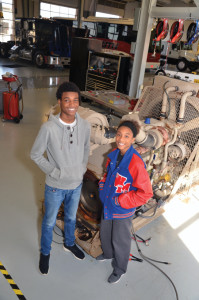
© 2016 by Steve Brawner Communications, Inc.
The late Lt. Governor Win Rockefeller used to say that the education system is like a string of water pipes laid end to end but not connected. In West Memphis, they’re connected.
The high school, known as the Academies at West Memphis, has a conversion charter, which is an arrangement with the Arkansas Department of Education where some of the usual rules don’t apply and the school can experiment and innovate.
Students there choose pathways that prepare them for a career and then can spend up to six of their eight high school periods a day at Arkansas State University Mid-South, the local community college 1.3 miles down the road. In fact, it’s possible for a 10th-grader, on the first day of school, to get on the bus and sit in a college class before ever sitting through a high school one.
High school students can take tuition-free, for-credit college classes at ASU Mid-South thanks to the Thomas Goldsby Scholarship, funded by a local oilman. If they’re dedicated enough, they can receive a college associate’s degree on the same stage where their receive their high school diploma. Then, because of ASU Mid-South’s connection with the ASU system and with various other four-year schools, they can further their education and receive a bachelor’s degree, even a master’s, on that same college campus.
In effect, West Memphis has become a college town without the state having to build a huge campus with dorms and a football stadium.
Most students who make the eight-minute bus ride from the high school to the community college aren’t seeking a college degree. Instead, they’re taking career-oriented classes in a variety of fields. For example, five high school students earned welding certifications last year and then after graduating went to work at TrinityRail Maintenance Services in Jonesboro earning about $18 an hour.
Perhaps the most interesting connection in West Memphis is the aircraft mechanics program shared by the high school, the college and FedEx, the Memphis-based package deliverer founded by Arkansas native Fred Smith. The company has invested $250,000 at ASU Mid-South to build a new FedEx Aviation Technology Center, which when completed this year will include aircraft hangar space and classrooms. It even donated a Boeing 727 plane whose shell is sitting on the college campus after being disassembled and transported by a Stuttgart company.
This means that, as part of his high school education, junior Jeremy Paige is learning to maintain a jet airplane. This time next year, he’ll be crawling around the plane as he earns his certification in airframe mechanics – the aircraft’s structure. After he graduates high school, he’ll further his education at ASU Mid-South and earn his certification in powerplant mechanics – the engine. With those two certifications, he can go to work for FedEx and make a six-figure income.
Meanwhile, senior Summer Abram is learning to be a FedEx diesel mechanic. She won’t make the same kind of money as Paige, but she has different long-term goals: Work while taking college courses and playing basketball at ASU Mid-South and studying to become a psychologist. If it all works out, she’ll be making a living at FedEx while in school instead of piling up student debt.
Is there a downside? Long term, perhaps there’s a danger that the pipeline will become too connected – that the system could just funnel students straight from school to their corporate sponsors’ workforce.
Of course, those sponsors are offering up to six-figure opportunities. Moreover, under this model, students have many choices other than a simple high school diploma, which is worth less than it used to be. As Dr. Glen Fenter, who was ASU Mid-South’s chancellor when all these deals were made, said, “The most powerful model for combatting the lingering vestiges of poverty in this country is to speed up the educational process, particularly for poor students.” Get them ready to earn a paycheck in a good job, he said, and then they can always travel different pathways from there.
How to do that? In West Memphis, they’re connecting high school to college and career opportunities, using a 1.3-mile pipeline and, for some, a jet airplane.
For more stories about how Arkansas schools are using innovative techniques to teach students, check out:
Goals, not grades, are the focus at Warren.
A marvelous day in a Marvell school.
No Child in Flippin left behind.
Good article, who provided the photo it looks very familiar.
“Is there a downside? Long term, perhaps there’s a danger that the pipeline will become too connected – that the system could just funnel students straight from school to their corporate sponsors’ workforce.”
Oh no! A decent job directly out of college? I fail to see the downside.